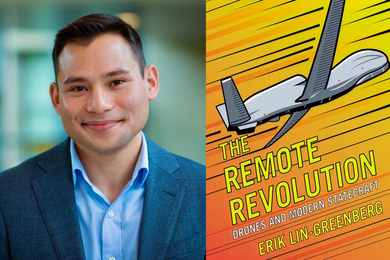After four years of negotiations, delegates from more than 140 countries met last January to finalize the first global treaty to mitigate and prevent mercury pollution, the Minamata Convention. Now, as delegates reconvene in October to sign the treaty, an MIT researcher analyzes its potential effectiveness.
"This is the first global treaty to tackle this major public health and environmental pollutant," says Noelle Selin, an assistant professor of engineering systems and atmospheric chemistry and a researcher with MIT's Joint Program on the Science and Policy of Global Change. "While the treaty may not be perfect, it's a step in the right direction."
Selin, who participated in the January meeting and plans to attend the October signing, evaluated the impact of the treaty in a study published this week in Environmental Toxicology and Chemistry. Her analysis finds that, once fully implemented, the greatest environmental benefits of the treaty will be from avoided increases in emissions.
The treaty addresses almost all mercury sources worldwide. But the actions required differ depending on the source of emissions, which include chemical and industrial processes such as the burning of fossil fuels, cement production, waste incineration and gold mining. For example, one provision of the treaty requires countries to devise national action plans to help limit and control artisanal and small-scale gold mining, one of the largest sources of mercury pollution at about 37 percent of emissions. Selin's assessment will help policymakers focus their attention on where they can make the most impact in reducing this harmful pollutant.
Selin calculates that once the treaty is fully implemented emissions will decrease slightly or stay at about today's levels. Because mercury takes decades to centuries to cycle through the environment, it will take a while before changes come into effect on a global scale. That explains why Selin's projections through 2050 show only a small decrease in environmental mercury levels, about 1-2 percent a year.
"Since mercury remains in the environment long after it is released, any decrease in mercury emissions will be slow to affect global mercury levels. This means that actions, or inactions, today will ultimately influence global levels long into the future," Selin says, stressing the significance of the treaty's progress, however limited.
"Without policy measures, mercury emissions are likely to increase dramatically and preventing these emissions today will benefit the environment in the long term. It's clear that the Minamata Convention will help countries prevent future emissions," Selin says. "But we shouldn't expect an immediate change in mercury pollution levels."
Selin also notes that because the immediate drops in mercury levels over the next few decades are expected to be minor, "such a small decrease is less than we can confidently quantify using existing methods."
The treaty, however, does include provisions to enhance monitoring capabilities. Selin makes several suggestions in her analysis of how to best make these enhancements. For example, she encourages different measurement techniques for organic and inorganic forms of mercury since they behave in unique ways in the global environment. In addition, because much of the benefit of the treaty will involve avoided emissions, comparison between models that project future emissions will be critical.
"There are major gaps in researchers' ability to measure mercury pollution," Selin says. "The Minamata Convention works to address these gaps. I look forward to seeing increased monitoring and research as the treaty is implemented around the globe. It's a strong step, but must be just the first of many."
"This is the first global treaty to tackle this major public health and environmental pollutant," says Noelle Selin, an assistant professor of engineering systems and atmospheric chemistry and a researcher with MIT's Joint Program on the Science and Policy of Global Change. "While the treaty may not be perfect, it's a step in the right direction."
Selin, who participated in the January meeting and plans to attend the October signing, evaluated the impact of the treaty in a study published this week in Environmental Toxicology and Chemistry. Her analysis finds that, once fully implemented, the greatest environmental benefits of the treaty will be from avoided increases in emissions.
The treaty addresses almost all mercury sources worldwide. But the actions required differ depending on the source of emissions, which include chemical and industrial processes such as the burning of fossil fuels, cement production, waste incineration and gold mining. For example, one provision of the treaty requires countries to devise national action plans to help limit and control artisanal and small-scale gold mining, one of the largest sources of mercury pollution at about 37 percent of emissions. Selin's assessment will help policymakers focus their attention on where they can make the most impact in reducing this harmful pollutant.
Selin calculates that once the treaty is fully implemented emissions will decrease slightly or stay at about today's levels. Because mercury takes decades to centuries to cycle through the environment, it will take a while before changes come into effect on a global scale. That explains why Selin's projections through 2050 show only a small decrease in environmental mercury levels, about 1-2 percent a year.
"Since mercury remains in the environment long after it is released, any decrease in mercury emissions will be slow to affect global mercury levels. This means that actions, or inactions, today will ultimately influence global levels long into the future," Selin says, stressing the significance of the treaty's progress, however limited.
"Without policy measures, mercury emissions are likely to increase dramatically and preventing these emissions today will benefit the environment in the long term. It's clear that the Minamata Convention will help countries prevent future emissions," Selin says. "But we shouldn't expect an immediate change in mercury pollution levels."
Selin also notes that because the immediate drops in mercury levels over the next few decades are expected to be minor, "such a small decrease is less than we can confidently quantify using existing methods."
The treaty, however, does include provisions to enhance monitoring capabilities. Selin makes several suggestions in her analysis of how to best make these enhancements. For example, she encourages different measurement techniques for organic and inorganic forms of mercury since they behave in unique ways in the global environment. In addition, because much of the benefit of the treaty will involve avoided emissions, comparison between models that project future emissions will be critical.
"There are major gaps in researchers' ability to measure mercury pollution," Selin says. "The Minamata Convention works to address these gaps. I look forward to seeing increased monitoring and research as the treaty is implemented around the globe. It's a strong step, but must be just the first of many."






